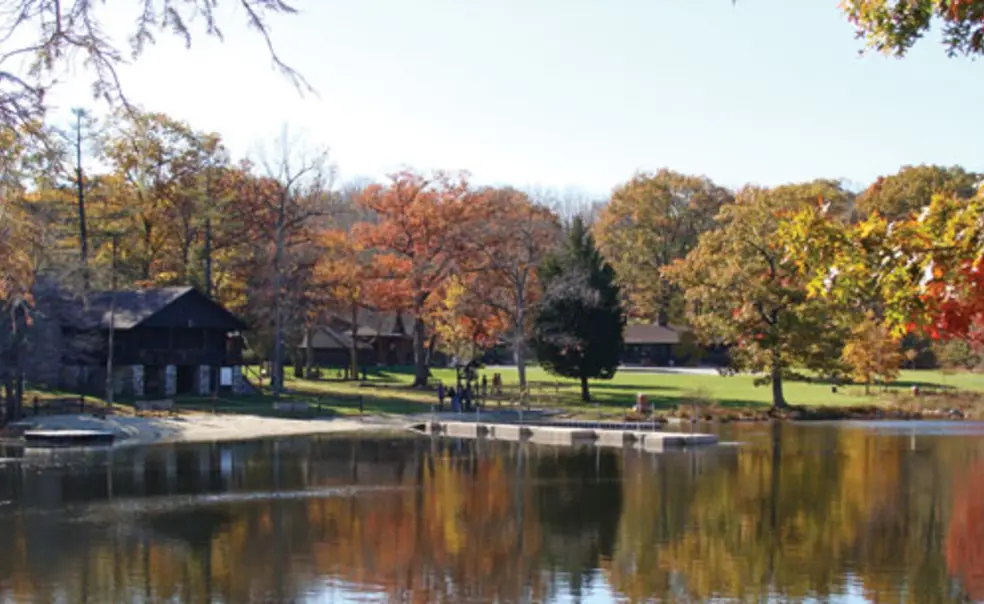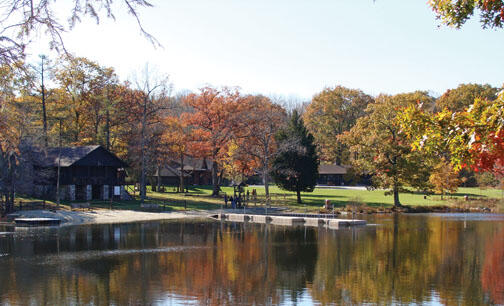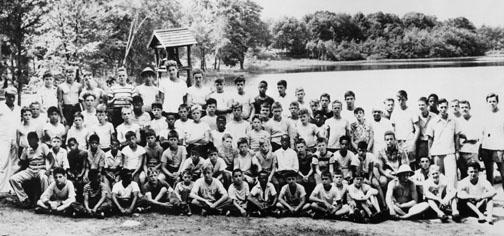What role for Blairstown?
Princeton examines its ties with a camp that serves urban youth 65 miles from campus
José Gonzales taught his students in no ordinary classroom — the children would kneel at the foot of a waterfall, attention fixed on a hemlock clinging to the cliff face. Their teacher was a masterful orator. A former fighter pilot and theater major before his career in experiential education, Gonzalez would lead the youth through confidence- and leadership-building activities in the outdoors. “See how the hemlock’s fight to grow has made it beautiful and strong,” he would say. “It won’t blow over in the first storm.”
During 30 years with the Princeton-Blairstown Center, until he retired in 2001, Gonzalez brought hundreds of campers from the inner cities of the tristate area to peer at the tree. The children would unpack the analogy, discussing how struggles within their environments have shaped them.
The Blairstown Center is a 263-acre wooded campground 65 miles from Nassau Hall that offers hiking trails, high and low ropes courses, a river, and Bass Lake. Against this backdrop, the camp runs weeklong social and emotional learning programs for at-risk urban youth.
But Blairstown recently has been weathering its own challenges. The departure of two executive directors in three years and the dwindling involvement of Princeton students in recent decades have shaped ongoing discussions between the University administration and the center’s leadership. A question mark hovers over the relationship between the two institutions.
Blairstown operates as an independent support organization of Princeton, with a private $20 million endowment managed by the Princeton University Investment Co. The University contributes 2 percent of the center’s $1.8 million annual budget and offers free use of University office space, information technology, and legal counsel. Blairstown staff members are entitled to University-employee benefits.
In return, the University expects that, like all its support organizations, Blairstown will contribute to Princeton’s core mission. “For many reasons, it remains important that Blairstown benefits Princeton students,” said Chris Shephard ’98, co-president of the Blairstown board of trustees.
The center’s leadership is developing a new strategic plan for the organization. Janet Dickerson, who retired in June 2010 as the University’s vice president for campus life, assumed co-presidency of the board with Shephard in December. She said that the planning initiative will look at how best to support both the University and the students “from urban areas or families who are underserved, for whom outdoor activities can enhance their experience in post-secondary education.”
Princeton, Dickerson said, long has recognized that Blairstown “was directly engaged in helping the University transition to a modern university, one that is integrated and that has made civic engagement one of its high-priority goals.”
Blairstown’s role as a center for civic engagement for Princeton students stems from its founding. The center emerged from the Princeton Summer Camp, created in 1908 for underserved boys by a student evangelical group, the Philadelphia Society of Princeton.
In 1930, Princeton students purchased the land of the current Blairstown site, located in Hardwick Township. The camp remained almost entirely student-run until the 1970s, and now operates as an independent 501(c)(3) organization.
Though programs offered by the center have changed over the decades, the “power of service, adventure, and reflection in the outdoors is an old idea,” Shephard said. In 1973, then-executive director John Danielson ’58 transformed the camp into a year-round facility and introduced its experiential education model. Danielson founded the freshman orientation program, Outdoor Action, at Blairstown in 1974.
In 2006, Blairstown launched programs in urban schools to help students from lower socioeconomic backgrounds enroll at institutions of higher education. Four facilitators run weekly sessions throughout the school year for a total of 350 students at three schools in Trenton and one in East Harlem. The programs include visits to both Blairstown and the Princeton campus.
To involve more Princeton students, the current executive director, Wardell Robinson-Moore, plans to hire a full-time staff member dedicated to student outreach. She hopes to see more student groups use the facilities and to attract students interested in urban youth and education issues. “In the last three years, we’ve seen a steady increase in the number of students coming up,” Robinson-Moore said.
While groups such as Outdoor Action, the Student Volunteers Council, and the Woodrow Wilson School graduate program have used the camp for years, new groups arrived last year, including the varsity lacrosse team and the Undergraduate Student Government. USG president Michael Yaroshefsky ’12 said the retreat was “remarkably successful,” praising both the staff and the beauty of the camp.
Shephard also has invited students to help lead Blairstown. In December, the trustees elected two M.P.A. students from the Woodrow Wilson School, Larry Handerhan and Elina Sarkisova, to join their ranks. Seven alumni sit on the 21-member board, and another alumnus is a staff member.
Cynthia Cherrey, Princeton’s vice president for campus life, said it would be premature to discuss the outcome of the talks with the center. Questions remain about how the institutional arrangement affects Blairstown’s ability to “give young people opportunities to challenge and define themselves,” she said, and how Princeton students may contribute to that mission.
Dickerson said that results of the discussions should grow clearer in coming months.













9 Responses
Chris Shephard ’98
9 Years AgoP.U.-Blairstown ties
The Philadelphian Society, created in 1825 and now incorporated as the Princeton-Blairstown Center (Campus Notebook, April 6), is America’s oldest University-affiliated service organization. A social entrepreneurship innovator and incubator, the organization helped found the intercollegiate YMCA movement in the 1870s, Princeton-in-Asia in the 1890s, the Student Volunteers Council in the 1960s, and Outdoor Action and the Alumni College seminar program in the 1970s.
The Philadelphian Society’s project called “the Princeton Summer Camp” began in 1908; the camp’s 11 cabins each were built by Princeton classes from 1894 to the 1939 “Freddy Fox” cabin. Thousands of Princeton students and tens of thousands of urban youth have come together since for outdoor-education programs to mutually strengthen character, leadership, and stewardship. Recently we have collaborated with Outdoor Action, the Center for African American Studies, the Pace Center for Civic Engagement, and the Program in Teacher Preparation.
Like Dwight Hall at Yale and Phillips Brooks House Association at Harvard, we are an independent nonprofit receiving human-resource services and other assistance from our host university. For many undergraduates, a summer’s work at Blairstown has been among their “best courses at Princeton.” For urban youth participants, the center has been a place to learn hope — believing in one’s self when others might have doubted, and gaining skills to pursue goals once thought beyond reach.
We are honored to be a part of Princeton’s unique commitment to include local service as a part of global citizenship, and to develop the civic conscience of students alongside their intellect, honoring what Woodrow Wilson in 1896 called “that progress which conserves.” In considering whether our work sufficiently supports Princeton’s core mission, we hope the University will continue our close partnership so together we may help lead society’s efforts to pursue urban equity and sustainability.
Robert J. Rivers Jr. ’53
9 Years AgoA long history of shared interests
I was fortunate to have an opportunity to attend the Princeton camp at Blairstown in 1946 as a young camper. African-American youngsters in a very different racial climate were invited to participate in a Princeton experiment to evaluate our ability to fit in with majority expectations. Sixty years ago, Princeton University students, who managed the camp, respected our humanity and supported our dreams, and since then I have experienced a lifetime of participation with both institutions.
The University’s former vice president for student life, Janet Dickerson, reminds us of Princeton’s remarkable change since 1946 with her comment in the article about Princeton-Blairstown’s role in Princeton’s transition to a modern university.
Princeton Summer Camp became Princeton-Blairstown Center, but the center continues to focus on the needs of the young in the greater community. The center and the camp have also valued the close relationship with the University since 1908.
The University and the center appear to have similar interests in the needs of the community beyond the Princeton campus. Both would like to have University involvement and student participation in this effort to bring hope and opportunity to those seeking a better life. And both hopefully recognize potential rewards for both institutions and enhanced value for the community if they can work together. After so many years of shared interest and combined effort, a fractured relationship is hard to comprehend.
Win Short ’41
9 Years AgoA historic association
When I retired in 1985, we moved to Princeton, and soon thereafter I joined the Blairstown board of trustees. For the following 15 years I had a firsthand view of the planning and operations at Blairstown. It was a challenging time because of the need to implement and staff a 12-month program. There were capital needs for programs and renovated facilities.
We met most of our goals drawing on the strength of our historic association with the University, which spanned two world wars and the Great Depression.
It would be tragic to break up this successful combination that recently celebrated its 100th anniversary!
Rodman P. Neumann ’76
9 Years AgoBe creative with Blairstown
In answer to “What Role for Blairstown?” (Campus Notebook, April 6, 2011): Blairstown epitomizes “Princeton in the nation’s service.” Just as the Student Volunteers Council was for me, Blairstown is about service, stewardship, and personal challenge. Princeton should continue the center’s status as a support organization and expand its potential in creative ways: Why not the Bass Lake Conferences on social issues?
First for me, Blairstown was the site of Episcopal Church retreats and Outdoor Action. When I completed Hurricane Island Outward Bound, John Danielson challenged me to become a leader with a remarkable group of Princeton students in creating an adventure program for urban youth as reconstruction began on the facilities, including a solar bathhouse. As we completed our training, we understood the challenges ahead, that Princeton-Blairstown Center represents service and challenge on many levels. We “leaders” composed a poem, the first letters of which spell “Together Challenged” (Trust Openly Group Everyone Together Helping Enriching Reaching, Consider How Awareness Lifts Life Enveloping New Growth Endlessly Diverse).
Such experiential adventure and education is Blairstown for countless youths, but especially for the many Princeton students who serve as leaders for the summer program, as participants or leaders for Outdoor Action, and as participants in departmental or spiritual retreats. After my master’s program, I was challenged to return to Blairstown to work with incoming director Ev Pinneo ’48, who is a key role model in the courage he and his family expressed by moving from a beloved home and comfortable careers to take on this service and challenge. Under his leadership we sought to make the site accessible year round to the University community, as well as to school groups and to the communities we served with the summer program.
Richard Peterson ’60
9 Years AgoAn essential role
The Blairstown operation may need an overhaul, but that is because it needs to continue to be a vital part of the Princeton experience! As a former counselor and then associate director of the summer camp in 1958 and ’59, I have strong memories; but more important, the many roles that the property there now plays make it all the more essential for future undergraduates and staff.
Susan Danielson k’58
9 Years AgoA Blairstown legacy
I grew up at the Princeton-Blairstown Center (PBC). My father, John Danielson ’58, spent most of his professional life serving Princeton University — in the admission office, in the dean of students office, in the Office of Development, and for a significant time at PBC. At PBC he was one of the visionaries, then executive director, then director of development, and finally a Board of Trustees member.
My father passed away two years ago, but I feel confident speaking on his behalf. He was always very grateful for the education that he pursued and received at Princeton; however, the education that found him and changed the course of his life, he encountered through his involvement with PBC. He was able to take the foundation of his Princeton University education and apply it in the service of the nation by supporting the work of the center to empower underserved youth from the New Jersey/New York/Pennsylvania region to chart courses for themselves that they otherwise might not have been able to.
My father told us often that parenting was his most important work, and that second to that was the work he did through PBC. I can say confidently that my father’s legacy took root at Princeton and took flight at Blairstown. As a second-generation PBC staff and board member, I believe that it would be a tragedy for the relationship between the University and the Princeton-Blairstown Center to dissolve or change in a way that would interfere with PBC’s (and by extension, the University’s) ability to serve the children of the nation in the way that it currently does and historically has.
Chris Shephard ’98
9 Years AgoContinue Blairstown-University partnership
Editor's note:
Tom Wertheimer ’60
9 Years AgoKeep Blairstown ties
Your article “What role for Blairstown?” (Campus Notebook, April 6) is timely, as the University considers whether to change its relationship with the Princeton-Blairstown Center (née Princeton Summer Camp) by ending its status as a support organization. Such a change not only would represent a profound loss, it also would be harsh and out of character for a university of Princeton’s stature with a widely touted commitment to teaching, research, and service.
As the article points out, the PBC has gone through some tough times in recent years with frequent leadership turnover, a fall-off in Princeton undergraduate involvement, and other challenges. Rather than focus on these problems and cast doubt on whether the center’s mission is congruent with its own, can’t the University and its relevant departments collaborate enthusiastically and constructively with the center to maximize its potential? This is a wonderful opportunity to reinvigorate and expand a historic partnership based on a shared commitment to community service. It is also a chance for the University to burnish its image as an institution that genuinely cares about its community.
Gifts, grants, and income from the center’s endowed funds cover the bulk of its operating costs. The vital support and services the University provides are a comparatively small price to pay to preserve and enhance Blairstown’s mission and to enrich the University’s co-curricular offerings for its students.
Let’s celebrate the enormous impact Blairstown (and its predecessor located on the Jersey shore from 1908 to 1930) has had — and can continue to have — on the lives and values of generations of Princetonians and, most importantly, on the future of urban youth and families.
Kate Brown
9 Years AgoPBC an influential training ground
It's been brought to my attention that Princeton-Blairstown Center (PBC) is in hard times, and that Princeton is thinking of discontinuing the center as a support organization of the University. As a former employee of PBC, I think this is unwise. The University is an integral part of the center and needs that relationship to foster the community development and quality learning it provides to underserved populations.
I was a PBC instructor and worked there for three years in two capacities: Idealistic and fresh out of my undergraduate years, I taught for a year; the following two years I served as the kitchen supervisor. These three years working and living in PBC’s wonderful, formative community were the best years of my professional life. I was an instructor for the first “Underground Railroad bike expedition,” which I later used as an ethnography in my master’s thesis. Here, I talked about the existential experience of the child in learning environments like PBC versus standard classroom learning. My work was published by CUNY Press. More importantly, this trip and others like it changed and enriched the lives of so many students and instructors. This work is very important, and it should be encouraged and funded.
I came to New York City for graduate school to pursue classroom teaching and quickly segued into a clinical direction, now pursuing my second master’s in social work. PBC shaped this in me. I regard the center as the hallmark of my professional training and try to incorporate its humanistic methods and practices into my freelance work with urban youth.
That said, PBC is not just an amazing place for children to come and grow and learn, but it is also a very progressive training ground for many teachers and clinicians like myself. I know many folks I worked with who have followed career paths similar to mine, and all would say that PBC was influential in the pursuit of good work and shaping them as teachers, activists, caregivers, and the like.
Please consider the formative impact PBC offers children and their communities, and please find a way to keep the relationship between the center and the University up and running for future generations.